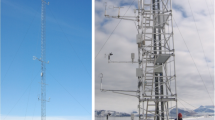Abstract
The French research aircraft equipped by the Institut National d'Astronomie et de Géophysique has been used to study turbulence in the planetary boundary layer. We present data analysis based on a quantitative description of the turbulence (successive moments) and on estimates of the vertical profiles of sensible and latent heat flux. The methods are applied first to measurements made in the surroundings of Toulouse (polyculture) and then in the Landes forest (south-west France). The vertical fluxes are calculated in the wavelength band between 10 m and about 5 km. The results show the importance of entrainment. In the case of sensible heat, entrainment leads to an inversion of the flux profile. The interpretation of the vertical flux variation, particularly in the case of latent heat, is complicated by the diurnal variation and by advection.
The moments of the third order of the basic parameters are analysed in the case of one flight where each level has been explored twice. The vertical wind component skewness is a maximum in the middle of the boundary layer because of thermal instability. For humidity and temperature, the skewness originates mainly at the stable layer level. As for temperature, we can observe a positive value of skewness near the ground due to the lack of temperature homogeneity, which is responsible for the instability.
Resume
L'avion de recherche français équipé par l'Institut National d'Astronomie et Géophysique est utilisé pour l'étude de la structure turbulente de la couche limite planétaire. On présente l'analyse des paramètres thermodynamiques acquis pour une description quantitative des caractéristiques turbulentes (moments successifs) et un estimation de la répartition verticale des transferts verticaux (flux de chaleur sensible et latente). Les méthodes présentées sont appliquées à une premiére campagne de mesures réalisée sur la région toulousaine (polyculture) et sur la forêt landaise (Sud-ouest de la France). Les flux verticaux sont calculés dans la bande de longueur d'onde entre 10 m et environ 5 km. Les résultats obtenus mettent en évidence l'importance de l'entraînement. Dans le cas de la chaleur sensible, il conduit à une inversion du profil du flux. L'interprétation de la répartition verticale des flux, en particulier dans le cas de la chaleur latente, est compliquée par la variation diurne et l'advection.
Les moments du troisième ordre des paramètres de base sont analysés dans le cas d'un vol où chaque niveau a été exploré deux fois successivement. La dissymétrie est maximale pour la vitesse verticale au milieu de la couche limite, sous l'effet de l'instabilité thermique. Pour la température et l'eau la principale source de dissymétrie est au niveau de la couche stable. Pour la température on observe au voisinage du sol une dissymétrie positive due aux inhomogénéités de température qui sont à l'origine de l'instabilité.
Similar content being viewed by others

Bibliographie
André, J. C., De Moor, G., Lagarrere, P., et Du Vachat, R.: 1976, ‘Turbulence Approximation for Inhomogeneous Flows: the Numerical Simulation of a Penetrative Convection Experiment’, J. Atm Sci. 33, 482.
Axford, D. N.: 1968, ‘On the Accuracy of Wind Measurements using an inertial platform in an aircraft’, J. Appl. Meteorol. 7, 645–666.
Ball, F. K.: 1960 ‘Control of Inversion Height by Surface Heating’, Quart. J. Roy. Meteorol. Soc. 86, 483–494.
Caughey, S. J. et Kaimal, J. C.: 1977, ‘Vertical Heat Flux in the Convective Boundary Layer’, Quart. J. Royal Meteorol. Soc. 438, 811.
Deardorff, J. W.: 1972, ‘Numerical Investigation of the Vertical Unstable Planetary Boundary Layer’, J. Atm. Sci. 29, 91–115.
Deardorff, J. W.: 1974, ‘Three-Dimensional Numerical Study of the Height and Mean Structure of a Heated Planetary Boundary Layer’, Boundary-Layer Meteorol. 7, 81–106.
Koprov, B. M. et Tsvang, L. R.: 1965, ‘Direct Measurements of Turbulent Heat Flux from an Airplane’, Izv. Atm. Oc. 6, 640–648.
Kukharets, V. P., Tsvang, L. R.: 1969, ‘Spectra of Turbulent Heat Flux in the Atmospheric Boundary Layer’, Izv. Atm. Oc. 11, 1132–1142.
Lenschow, D. H.: 1970, ‘Airplane Measurements of Planetary Boundary Layer Structure’, J. App. Meteorol. 9, 874–884.
Lenschow, D. H.: 1972, ‘The Measurement of Air Velocity and Temperature using the NCAR Buffalo Aircraft Measuring System’, NCAR Technical Notes NCAR-TN/EDD74.
Lenschow, D. H.: 1976, ‘Estimating Updraft Velocity from an Airplane Response’, Month. Weather Revue 104, 618–627.
McBean, G. A. et McPherson, J. I.: 1976, ‘Turbulence above Lake Ontario Velocity and Scalar Statistics’, Boundary Layer Meteorol. 10, 181–197.
Monin, A. S. et Zilitinkevich, S. S.: 1967, ‘Planetary Boundary Layer and Large Scale Atmospheric Dynamics’ Report of the Study Conference on GARP-WMØ, Stockholm.
Obukhov, A. M.: 1971, ‘Turbulence in Atmosphere with a Non-Uniform Temperature’, Boundary-Layer Meteorol. 2, 7–29.
Penell, W. T. et Le Mone, M. A.: 1974, ‘An Experimental Study of Turbulence Structure in the Fair-weather Trade Wind Boundary Layer’, J. Atmos. Sci. 31, 1308.
Ravault, M.: 1973., ‘L'avion de recherches atmosphériques de l'INAG’, J. Rech. Atm. 4, 235.
Readings, C. J. et Butler, H. E.: 1972, ‘The Measurement of Atmospheric Turbulence from a Captive Balloon’, Meteorol. Mag. 101, 286–298.
Sommeria, G.: 1974, Modèle tri-dimensionnel pour la simulation numérique de la couche limite planétaire. Application à la couche limite tropicale. Thèse de doctorat d'état es sciences physiques. Uníversíté de Paris VI.
Telford, J. W., Vaziri, A., et Wagner, P. B.: 1976, ‘Aircraft observations in the planetary boundary layer under stable conditions’, Boundary-Layer Meteorol. 10, 353–377.
Warner, J.: 1971, ‘Observations of the Eddy Fluxes of Heat and Vapour over the Sea’, Quart. J. P. Meteorol. Soc. 97, 540–547.
Warner, J.: 1973, ‘Spectra of the Temperature and Humidity Fluctuations in the Marine Boundary Layer’, Quart. J. Roy. Meteorol. Soc. 99, 82–88.
Zilitinkevich, S. S.: 1972, ‘Turbulent Boundary Layer in Parametrization of Sub-grid Scale Processes’, Joint Organizing Committee, GARP publication 8 WMØ p. 69–80.
Author information
Authors and Affiliations
Rights and permissions
About this article
Cite this article
Druilhet, A., Guedalia, D. & Fontan, J. Quelques caractéristiques de la turbulence dans la couche limite planétaire. Boundary-Layer Meteorol 15, 147–162 (1978). https://doi.org/10.1007/BF00121918
Received:
Issue Date:
DOI: https://doi.org/10.1007/BF00121918



